The White Clown
I
am the white clown, who travels
from
village to town, who says little
and
preaches much. You laugh at me
cry
for me, feel the pains that I
have
endured for you, walked steps
upwards
and downwards for you—
the
dancing clown, harlequin’s laughing
clown,
the stage walker who died in a duel
one
snowy morning, who was not resurrected
on
Easter, who fled with the demon horsemen.
Our
family circused for generations.
Poppy
died on the high wire.
Before
his fall, we crossed deserts
moved
to the mountains where
Swiss
cottages dotted the miraculous lake.
We
fished, and we caught many fish, which
we
shared with the strangers who had
come
to hear my message.
We
divided the loaves.
Crowds
grew and followed us.
We
traveled in their lands and then
into
other lands, the wagons swaying
the
lanterns’ lights twinkling in the darkness.
My
Venus sat beside me, pouring wine
into
my cup, looking toward heaven
her
hand squeezing my thigh.
She
was young and beautiful, with
auburn
hair, green eyes, long legs.
Her
walk could drive a man wild.
Great
masters have seen her as ugly
as
a haggard old woman without teeth
as
lovely as I. She was not repentant
did
not wash my feet. Instead she gazed
out
at me from Botticelli’s canvas and
held
my hand as we stepped into the ocean.
We
rode the waves together, called
upon
Poseidon to bring us his chariot.
Then
we left the old man with his nymphs.
In
the spring, dogwoods blossomed.
The
flowers grew into leaves.
Our
caravan disbanded.
I
gave up mandolin and turned
to
three rings, performed indoors
painted
my nose, wore striped pants
lost
my hair as well as my waistline
practiced
celibacy.
It
was for you, all for you

-- Red Skelton
“The White Clown” should be viewed as an Easter commentary, especially in its first stanza (despite the explicit reversal at the end of the stanza), the sidelong allusions in the second stanza (the deserts, the loaves and fishes, the large crowds, even the reference to Poppy dying on the high wire) and, of course, the poem’s closing line. However, it is not an Easter allegory; it merely uses the Christian motifs as a resonant background to his personal tale of love and sacrifice.
ReplyDeleteSandro Botticelli was a 15th-century Florentine painter. His illustration of the first printed edition of Dante’s “Inferno” was a seminal literary-artistic event, but he is best known for his painting, “The Birth of Venus” (portrayed as “young and beautiful, with auburn hair, green eyes, long legs” emerging triumphantly from a scallop half shell on the shore). Under the influence of the puritanical Dominican friar Girolamo Savonarola, Boticelli first turned from decorative to devout art and then ceased painting altogether, perhaps even going so far as burning his own paintings in the infamous Bonfire of the Vanities in 1497, when moralistic mobs collected and destroyed thousands of books, artworks, mirrors, musical instruments, fine clothing, playing cards, cosmetics, and other vain, idolatrous objects.
Coincidentally, in “Corteo,” a Cirque du Soleil extravaganza, the White Clown, a would-be authority figure, opens the door to the magic of the circus for the Dead Clown, who watches his own funeral taking place in a carnival-like atmosphere.